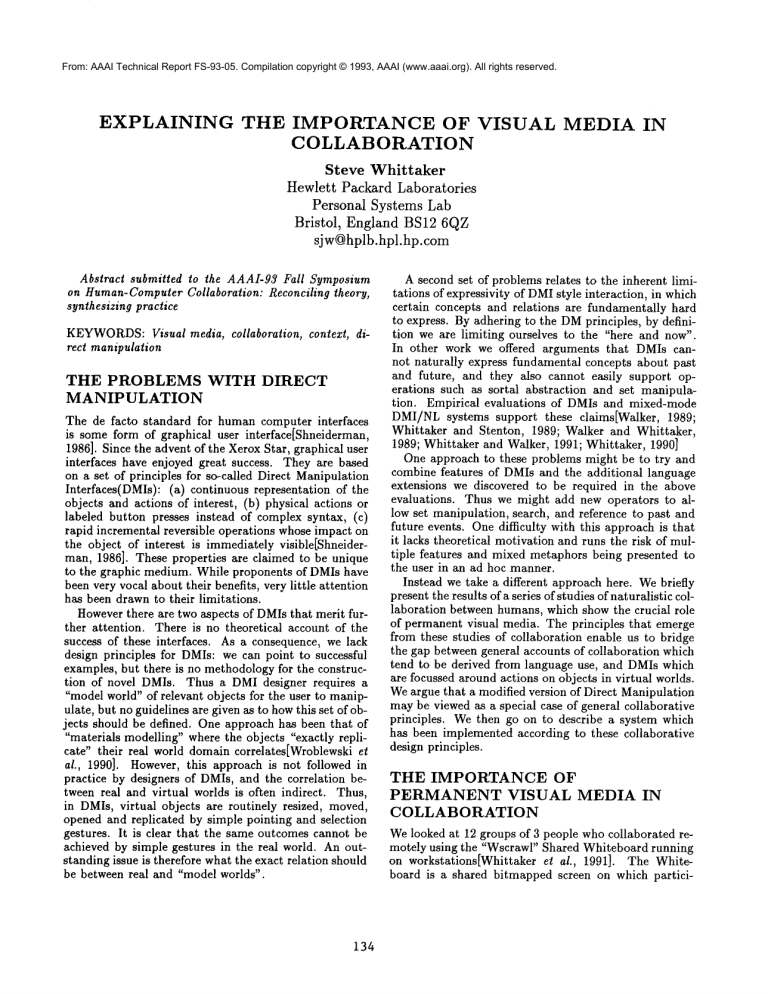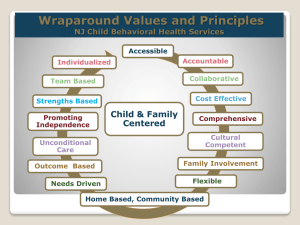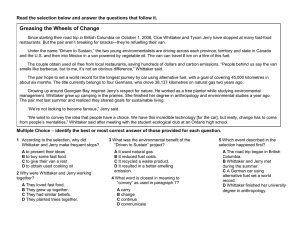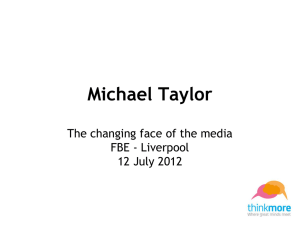
From: AAAI Technical Report FS-93-05. Compilation copyright © 1993, AAAI (www.aaai.org). All rights reserved.
EXPLAINING
THE IMPORTANCE OF VISUAL
COLLABORATION
MEDIA IN
Steve
Whittaker
Hewlett Packard Laboratories
Personal
Systems Lab
Bristol,
England BS12 6QZ
sjw@hplb.hpl.hp.com
Abstract submitted to the AAAI-93 Fall Symposium
on Human-ComputerCollaboration: Reconciling theory,
synthesizing practice
KEYWORDS:
Visual media, collaboration,
rect manipulation
THE
PROBLEMS
MANIPULATION
WITH
context,
di-
DIRECT
The de facto standard for human computer interfaces
is some form of graphical user interface[Shneiderman,
1986]. Since the advent of the Xerox Star, graphical user
interfaces have enjoyed great success. They are based
on a set of principles for so-called Direct Manipulation
Interfaces(DMIs): (a) continuous representation of
objects and actions of interest, (b) physical actions
labeled button presses instead of complex syntax, (c)
rapid incremental reversible operations whose impact on
the object of interest is immediately visible[Shneiderman, 1986]. These properties are claimed to be unique
to the graphic medium. While proponents of DMIs have
been very vocal about their benefits, very little attention
has been drawn to their limitations.
Howeverthere are two aspects of DMIsthat merit further attention. There is no theoretical account of the
success of these interfaces. As a consequence, we lack
design principles for DMIs: we can point to successful
examples, but there is no methodologyfor the construction of novel DMIs. Thus a DMI designer requires a
"model world" of relevant objects for the user to manipulate, but no guidelines are given as to howthis set of objects should be defined. One approach has been that of
"materials modelling" where the objects "exactly replicate" their real world domain correlates[Wroblewski et
al., 1990]. However, this approach is not followed in
practice by designers of DMIs, and the correlation between real and virtual worlds is often indirect. Thus,
in DMIs, virtual objects are routinely resized, moved,
opened and replicated by simple pointing and selection
gestures. It is clear that the same outcomes cannot be
achieved by simple gestures in the real world. An outstanding issue is therefore what the exact relation should
be between real and "model worlds".
134
A second set of problems relates to the inherent limitations of expressivity of DMIstyle interaction, in which
certain concepts and relations are fundamentally hard
to express. By adhering to the DMprinciples, by definition we are limiting ourselves to the "here and now".
In other work we offered arguments that DMIs cannot naturally express fundamental concepts about past
and future, and they also cannot easily support operations such as sortal abstraction and set manipulation. Empirical evaluations of DMIs and mixed-mode
DMI/NLsystems support these claims[Walker, 1989;
Whittaker and Stenton, 1989; Walker and Whittaker,
1989; Whittaker and Walker, 1991; Whittaker, 1990]
One approach to these problems might be to try and
combine features of DMIsand the additional language
extensions we discovered to be required in the above
evaluations. Thus we might add new operators to allow set manipulation, search, and reference to past and
future events. One difficulty with this approach is that
it lacks theoretical motivation and runs the risk of multiple features and mixed metaphors being presented to
the user in an ad hoc manner.
Instead we take a different approach here. Webriefly
present the results of a series of studies of naturalistic collaboration between humans, which show the crucial role
of permanent visual media. The principles that emerge
from these studies of collaboration enable us to bridge
the gap between general accounts of collaboration which
tend to be derived from language use, and DMIs which
are focussed around actions on objects in virtual worlds.
Weargue that a modified version of Direct Manipulation
maybe viewed as a special case of general collaborative
principles. Wethen go on to describe a system which
has been implemented according to these collaborative
design principles.
THE
IMPORTANCE
OF
PERMANENT
VISUAL
MEDIA
IN
COLLABORATION
Welooked at 12 groups of 3 people whocollaborated remotely using the "Wscrawl" Shared Whiteboard running
on workstations[Whittaker
el at., 1991]. The Whiteboard is a shared bitmapped screen on which partici-
num.B,
num. Da
garage
-windows. ught
carpeting
..sQuaretoor.a~e _
room ~or r~- ~
neighborhood
cost (ugggh !
landscaping
goo.d roof
i
.,~-~--are these supp )sed to be ~bvious
things, or thing is you dord think
about?
underground utilities
copper water pipes
no a~bestos in ceiling
crawl space for wiring
?
i
j~’t ran& your choice~
Figure 1: Screen Dumpfor House Selection Task
pants can type or draw inputs. Transmission is instantaneous. The system also allows gesture via pointing.
All input modes are selected from menu options. The
users worked together on two tasks. The first was a
brainstorming task in which the objective was to produce a prioritised list of 7-10 items to complete the following sentence: "Whenbuying a house the critical features that the house must possess are .... ". The second
involved calendar coordination: each participant had a
weekly calendar with many appointments already scheduled and the aim was to arrange two two-hour meetings
that all three could attend. Wevideotaped both tasks,
transcribed every input by each of the participants and
conducted the analysis on the transcripts.
Figure 1 shows a typical set of inputs for the House
Selection brainstorming task, that occurred halfway
through the task. Inputs by the different users appear in
the different fonts. Onthe left hand side is a vertical list
of suggested items constructed by all users, and on the
upper right is a Table with columns for each person for
rating the priorities of the items. The lower right contains a textual question concerning the status of items
on the list, a query mark and a textual answer to the
question.
Weanalysed all user inputs. Wefound that these fell
into three main classes: (a) text; (b) gestures; (c)
sual datastructures, such as tables, lists, matrices and
calendars. The most striking aspect of the data was the
central role of these Visual Datastructures which we labelled ARTIFACTS
which accounted for 30%of inputs. In
addition almost all the gestures were directed at ARTIFACTS,and this accounted for a further 14%of inputs.
The ARTIFACTS seemed to be used to carry the content
of the discussion, as a target for gesture, they were a focus for group activity, and a meansto record the group’s
evolving solution to the problem.
135
One possibility is that ARTIFACTS
could be generated
because our participants were communicating using only
permanent media, namely typing, and drawing. In a second study we allowed participants to communicateusing
speech as well as the Workspace. Strikingly, ARTIFACTS
were as frequent when speech was available, as for com~.
munication with Workspace alone
WHEN AND WHY ARE ARTIFACTS
EFFECTIVE?
In our next study[Whittaker et al., 1993], we attempted
to identify reasons why ARTIFACTS
were so effective.
Here we looked at communication between pairs of participants who have access to both speech communication
and a Shared Workspace and compared this with communication when participants only had access to speech.
Weinvestigated communicationeffectiveness for 3 tasks
possessing key representative features of workplace activity. These tasks involved (a) producing a six point summary of joint work objectives; (b) agreeing changes and
editing a two page document; (c) producing a solution
to a spatial design task. For the task requiring the joint
production of short summaries we found no benefits associated with ARTIFACTS.For the more demanding text
editing task, when the task was familiar, participants
performed more efficiently
with speech and ARTIFACTS
than with speech alone. Whenthe task was graphical design, ARTIFACTS were associated with greater efficiency
2.
and also changed the nature of communication
~This result is highly significant given the manyclaims
that speech is the single most effective communication
channel and that adding other media to the speech channel does
not improve communicationfor a variety of information exchange and problem-solving tasks[Chapanis, 1975].
2All differences reported here are statistically significant
on ANOVA
tests.
How can we explain these results?
Here the ARTIFACTseemed to be serving three main functions.
In the
graphical design task it allowed the depiction of complex visual objects and spatial relationships.
This was
demonstrated by the fact that reference was achieved
in many fewer turns when the ARTIFACTWas available.
The extract below shows the participants
trying to identify a particular
object to insert in their design, when
interacting
using only speech.
Example: Furniture Task - Audio only
I.A: right - can you describe it to me
a little bit
2.F: the 12 x I0 one - the 12 is the
height the I0 is the base ok
3.A: how will it fit into the 12 x I0
square I put on my screen?
if I start from the top left corner
4.F: top left corner ok
S.A: can I go along 107
6.F: yes go along I0
7.A: ok - alright and now I am on the
right hand side?
8.F: no actually - on the top right
hand corner - right?
9.A: ya - top right hand corner
....... 26 MORE TURNS ABOUT
THE SAME OBJECT .........
36.F: so that’s what you got, that’s a
big piece it’s worth 40 points - - - ok
was much more frequent
when there were ARTIFACTS.
Finally,
ARTIFACTSembodied the prior context of the
task. They acted as external
memory aids encapsulating what had been achieved so far in the task, and to
some extent what remained to be done. Thus in both
the complex verbal editing task and the graphical design
task the participants
agreed a complex set of changes to
the document or design. By recording the changes directly on the shared visible
permanent ARTIFACT, the
participants
avoided having to remember those changes.
The ARTIFACTthus provided a record of certain crucial
parts of the prior context. This was useful for material
that was difficult
for participants
to remember, such as
complex syntactic changes in the document editing task
or changes to a complex visual object on the design task.
In contrast, we found little benefit for ARTIFACTS
in the
short summary task. This task required participants
to
generate and agree on a list of six verbal items which
was much less demanding of verbatim memory, and consequently the presence of ARTIFACTSshowed far fewer
benefits.
IMPLICATIONS
AND RELATION TO
THEORIES OF COLLABORATION
AND DISCOURSE
The description of a single piece has taken 36 turns and
required various clarifications
by the person who cannot
see it (Eg Turns 3, 5, 7). The pattern of interaction
was
very different
when the Workspace was added:
Example: Furniture Task - Audio ~ Workspace
I. A: right now, I got some objects that
can fit in a I0 x 12 which is worth 40
points - do you want me to scribble it
in?
2. F: yes --- I0 x 12 --- I’ve got a 8 x
12
3. A: go I0 x 12 that fit in there that
is worth 40 points
4. F: ok yours is more than mine - keep
going
5. A: I am not quite sure how to do it
but here we go ..... ya, that’s not
very good - and that’s worth 40
The description
of a similar piece by the same pair
took just 5 turns, and required no clarifications,
because
people were able to draw it (as indicated by Turns 1, 4,
5).
As in the previous studies these graphical
objects
could be then be referred to using deixis, and again deixis
136
What are the implications of these results for interface
design and theory? The above studies show the importance of PERMANENT
VISUAL MEDIA in collaboration.
These media have three crucial properties:
they provide a visible CONTEXT
for the current interaction,
an
EXTERNALISATION
or record of aspects of the preceding
discussion, they also serve as targets for straightforward
reference using DEIXIS.
These properties
are important
because they address key problems in discourse and interaction,
relating to COMMON
KNOWLEDGE[Clarkand Marshall,
1981;
Stalnaker,
1984]. It is well established
that the literal meaning of an utterance underspecifies its intended
meaning[Searle, 1975]. Listener interpretation
therefore
requires the incorporation of information external to the
utterance.
A critical
part of this COMMON
KNOWLEDGE
consists of the conversational record, ie. the set of entities and events that have been referred to and evoked,
in the prior conversation.
This record is used to delimit inferences
about intended speaker meaning. One
well-attested
use of the conversational record is for determining reference and anaphora resolution[Brennan
et
al., 1987; Grosz el aL, 1986; Sidner, 1979].
How do ARTIFACTS address
these COMMONKNOWLEDGEproblems? In normal spoken interaction
participants are faced with several real time cognitive demands:
in addition to processing each incoming utterance,
they
have to retain and update the conversational
record in
memory. They also have to make relevant
inferences
based on this record. These problems are exacerbated in
face-to-face
interaction
by the fact that the media used
in face-to-face interaction namely, speech, gaze and gestural media are ephemeral.
This means that certain
aspects of processing have to be done rapidly before information is forgotten.
In contrast,
PERMANENT VISUAL MEDIA reduce the
cognitive load in a number of important respects. By
the fact that they persist over time, ARTIFACTS
provide
a visible backdrop and resource for interaction. Firstly
they provide an externalisation of the set of entities that
are likely to be talked about. Secondly people make
changes to ARTIFACTS as the discussion progresses, so
ARTIFACTS
provide an encapsulation of crucial parts of
the unfolding conversational record. In both cases, the
ARTIFACTS contribute to the construction and maintenance of COMMON KNOWLEDGE and reduce the burden of memoryand inference for participants. In addition, ARTIFACTS
support reference via deixis, reducing
the need for complex inference associated with planning
and interpreting referring expressions.
SYSTEM
Weinstantiated these principles in a mixed-modequery
interface called ’Query By Format’, which exploits the
properties of ARTIFACTS
described above. The interface supported user queries to a very large commercial
database containing information about marketing, products and sales. The interface was designed for a user population who were domain experts but were not prepared
to learn a formal query language such as SQL. The two
modes supported were Direct Manipulation and Natural
Language input.
COVERAGE
A critical problem for interface designers is that of COVERAGE,namely the presentation to the user, of the
set of system entities and relations and the operations
that the system will support[Ogden and Brooks, 1983;
Ogden and Sorknes, 1987J. A key requirement here is to
present the set of entities, relations and operations that
are not supported by the interface, to avoid the generation of invalid queries.
Coverage can be seen as part of the COMMONKNOWLEDGE problem described above, and our solution here invokes the notion of ARTIFACTS.
The information stored
in the database is visually displayed in the form of ’Domain Models’. The Domain Models each represent one
dimension of database information, and they reveal the
dimension in terms of concepts and structures that are
meaningful to the users (eg. an organisation chart or
desk calendar). A schematic diagram of the system Interface is shown in Figure 2. The Domain Models are
shownon the left side of the Figure and they represent
both the Organisation Chart and temporal intervals in
a Calendar. These models are permanently present on
the screen. These user-centered models are then used
to construct reports by the selection and combination
of either concepts (eg. Department or Quarter) or their
values (eg. Employee A or March’91).
Selection takes place by clicking on the relevant concepts and values. The models therefore provide a visible
137
manifestation of the set of entities and relations that are
represented in the system. In this way users are shielded
from the complex details of the database’s internal representations, while being provided with direct access to
the lexicon for their queries, thus increasing the likelihood of well-formed queries. The results of the queries
are displayed on the right hand side of Figure 2 as a
set of matrices showing employee by time interval, but
users have choices about how they wish the results to be
displayed, as lists, bar charts or tables.
CONTEXT
AND THE
CONVERSATIONAL
RECORD
A second key feature of the interface is that it preserves a visible record of the evolving interaction, which
can be manipulated and incrementally refined. Generic
database query is best characterised as a process of approximation and incremental refinement rather than success with a one-shot query[Whittaker and Stenton, 1989].
A critical feature of refinement is that it involves re-use
of prior queries and the results of those queries. Systems
based around traditional query languages such as SQL
and QBEcan provide only limited support for the use
of contextual information, and do not easily allow the
reformulation of previous queries. They have no mechanism for allowing reference to previous answers. Such
restricted re-use of context leads to greater complexityin
the formation of queries and redundancy when following
up on initial information.
Our empirical studies of collaboration indicated the
critical role of ARTIFACTS
as an externalisation of the
evolving conversational record and we attempted to
replicate this in Query By Format by making visible and
manipulable the results of prior queries.
Query By Format supports the re-use of both previous
queries and answer elements, to facilitate the incremental development of a line of questioning. These results
can be refined to create new queries and Domain Models by directly acting on the resultant matrix, list or
bar chart and adding, replacing or expanding visual elements. The results therefore act as dynamic domain
models constructed on the fly, which enable the resolution of a possibly complex query by the manipulation
of intermediate queries. Successive refinement is shown
in Figure 2: Matrix 1 in the upper right has been refined, both by exploding Q1 into its component months
(J,F,M) and by adding an extra employee (Person
producing Matrix 2 in the lower right. If users wish,
Matrix 2 can in turn be refined, or if Matrix 2 is unsatisfactory they may return to Matrix 1, or generate a
entirely new query.
Longer term management of context is provided by
facilities for the saving and copying of previous queries.
These maybe saved to file and restored individually or as
a complete set, and hence maybe re-used across sessions.
As well as supporting user-initiated copying, the system
automatically produces a copy of a query whenever one
with results displayed is further edited (thus retaining
"trail" of intermediate results). In this way significant
i PERSONA
NATURAL
LANOUA{3E I
PIERS
ON C
PERSON D
WHICHOF THE~EIS THE LARGEST?
Figure 2: Schematic interface
points in the dialogue are retained and can be returned
to at a later point.
for Query by Format
of the principles of DMcan be explained by our current approach, namely: physical actions or labeled button presses instead of complex syntax. This can now
DEIXIS
be explained in terms of the need to support DEIXIS.
Finally muchof the interaction in the interface can be
Furthermore, if we extend the DMnotion of "continuachieved using deixis, by pointing and clicking on various
ous representation of the objects and actions of interest"
entities rather than naming them. Deixis can also be
to explicitly include previous actions and their results,
used to combine modes. One can click on a series of
then our requirement for CONTEXT
is satisfied.
entities to select them and then use Natural Language
What of the third DMIprinciple, ie. rapid incremento ask a further query. For example, one might select
tal reversible operations whose impact on the object of
a series of cells from the matrices and then type in the
interest is immediately visible? Our work here on increNLquery Which of these is the largest?, as depicted in
mental query has empirically demonstrated the imporFigure 2. In this way, deixis can be used to restrict the
tance of incrementality, but how can we explain the need
domain of the NL query.
for this feature? Again this would seem to relate to the
One benefit of using Deixis in these situations relates
requirement for COMMONKNOWLEDGE: an incremental
to COVERAGE. Reference and selection
using gesture
style of interaction allows for frequent checks of shared
mean that users do not have to remember the names of
understanding[Clark and Schaefer, 1989; Whittaker and
entities or relations, because these are constantly visible.
Stenton, 1988; Walker and Whittaker, 1990]. Frequent
Again this is a meansto reduce the user’s cognitive load.
checks mean that divergences in understanding can be
detected and rectified soon after they occur. Our work
CONCLUSIONS
on naturalistic communicationover videoconferences has
shown the importance of this feature, in communication
Webegan with an analysis of some of the drawbacks of
media such as speech[O’Conaill et al., 1993]. Wheninthe DMI approach. One criticism was that we do not
crementality of communication is not supported by the
have a clear theoretical understanding of the success of
system, we found evidence for failure to detect differthis approach. The results of our empirical studies have
ences in mutual understanding.
indicated a way that we might attempt to bridge the
gap between successful practice and theory. Our natuWhile this approach has attempted to explain the unralistic studies of collaboration showed the importance
derlying principles for DMIsin terms of general collaboof permanent visual media, which we called ARTIFACTS rative principles, DMIsare nevertheless restricted in the
ways that we have documented in earlier work[Walker,
in supporting crucial aspects of joint work. Furthermore
we were able to design a system which successfully used
1989; Whittaker and Stenton, 1989; Walker and Whitpermanent visual media to support COVERAGE, CONtaker, 1989; Whittaker and Walker, 1991; Whittaker,
TEXT for query refinement and re-use, and DEIXISfor
1990]. Further research on mixed-modeinterfaces which
reference.
combine the expressivity of NL, with the key features of
Howdoes this relate to the heuristically generated
DMIsoutlined here, are necessary to address this probDMIprinciples[Shneiderman, 1986]? It seems that one
lem.
138
[Searle, 1975] John R. Searle. Indirect speech acts. In
P. Cole and J. L. Morgan, editors, Syntax and Semantics III: Speech Acts, pages 59-82. Academic Press,
NewYork, 1975.
[Shneiderman, 1986] Ben Shneiderman. Designing the
User Interface:
Strategies for Effective HumanComputer Interaction. Addison Wesley, 1986.
[Sidner, 1979] Candace L. Sidner. Toward a computational theory of definite anaphora comprehension in
english. Technical Report AI-TR-537, MIT, 1979.
[Stalnaker, 1984] Robert C. Stalnaker. Inquiry. MIT
Press, 1984.
[Walker and Whittaker, 1989] Marilyn Walker and
Steve Whittaker. Whennatural language is better
than menus: A field study. Technical Report HPLBRC-TR-89-020, Hewlett Packard, Bristol, England,
1989.
[Walker, 1989] Marilyn A. Walker. Natural language in
a desk-top environment. In Proceedings of HCI89, 3rd
International Conference on Human-ComputerInteraction, Boston, Mass, pages 502-509, 1989.
[Walker and Whittaker, 1990] Marilyn A. Walker and
Steve Whittaker. Mixedinitiative in dialogue: An investigation into discourse segmentation. In Proc. 28th
Annual Meeting of the ACL, 1990.
[Whittaker, 1990] Steve Whittaker. Simulating agency.
Technical report, HPLabs, Bristol, England, 1990.
[Whittaker, 1993] Steve Whittaker. Towards a theory of
mediated communication. To Appear in HCI, 1993.
This work also relates to the issue of delegation between system and user. Wehave seen that in naturalistic collaborations, people supplement their cognitive
systems by the use of ARTIFACTS
which serve to support
CONTEXT, as memory aids to encapsulate
the current
state of problem-solving, and as targets for reference via
DEIXIS.The results here suggest that our systems should
support these functions in order to overcomethe resource
boundedness of users by tracking context, retaining previous solutions and assisting in reference. The system we
implementedsuccessfully adhered to these principles.
Finally the work addresses the relationship between
collaboration and different communication media. We
have shown that permanent visual media can be used
to overcome some of the weaknesses of ephemeral media such as speech. Future systems and theory should
combine interaction media in ways that allow us to exploit their strengths and avoid their weaknesses[Whittaker, 1993].
References
[Brennan et al., 1987] Susan Brennan, Marilyn Walker
Friedman, and Carl J. Pollard. A centering approach
to pronouns. In Proc. 25th Annual Meeting of the
ACL, pages 155-162, 1987.
[Chapanis, 1975] A. Chapanis. Interactive human communication. Scientific American, 232:34-42, 1975.
[Clark and Marshall, 1981]
Herbert H. Clark and Catherine R. Marshall. Definite reference and mutual knowledge. In Elements
of Discourse Understanding, pages 10-63. Cambridge
University Press, Cambridge, 1981.
[Clark and Schaefer, 1989] Herbert H. Clark and Edward F. Schaefer. Contributing to discourse. Cognitive
Science, 13:259-294, 1989.
[Whittaker et al., 1991] Steve Whittaker, Susan Brennan, and Herbert H. Clark. Co-ordinating activity:
An analysis of computer supported co-operative work.
In Conference on Computer HumanInteraction, pages
361-367, 1991.
[Whittaker et ai., 1993] Steve Whittaker, Erik Geelhoed, and Elizabeth Robinson. Shared workspaces:
How do they work and when are they useful? International Journal of Man-MachineStudies, 1993.
[Whittaker and Stenton, 1988] Steve
Whittaker and Phil Stenton. Cues and control in expert
client dialogues. In Proc. 26th Annual Meeting of the
ACL, pages 123-130, 1988.
[Whittaker and Stenton, 1989] Steve Whittaker and
Phil Stenton. User studies and the design of natural language systems. In Proc. 4th Conference of the
European Chapter of the ACL, pages 116-123, 1989.
[Whittaker and Walker, 1991]
Steve Whittaker and Marilyn Walker. Towards a theory of multimodal interaction.
AAAI Workshop on
Multimodal Interaction, 1991.
[Wroblewski et al., 1990] David Wroblewski, Timothy
McCandless, and William Hill. Agency considered
harmful. In Proceedings of the AAAI workshop on
Knowledge-Based HCI, 1990.
[Grosz et al., 1986] Barbara J. Grosz, Aravind K. Joshi,
and Scott Weinstein. Towards a computational theory
of discourse interpretation.
Unpublished Manuscript,
1986.
[O’Conaill et al., 1993] Brid O’Conaill, Steve Whittaker, and Sylvia Wilbur. Conversations over videoconferences: An evaluation of video-mediated interaction. To Appear in HumanComputer Interaction,
1993.
[Ogden and Brooks, 1983] William C. Ogden and Susan R. Brooks. Query languages for the casual user:
Exploring the ground between formal and natural languages. In Proc. Annual Meeting of the Computer Human Interaction of the ACM,pages 161-65, 1983.
[Ogden and Sorknes, 1987] William C. Ogden and Ann
Sorknes. What do users say to their natural language
interfaces? In Human-ComputerInteraction, Interact
1987, Elsevier Science Publishers B. V. North Holland,
pages 561-66, 1987.
139





![013—BD Global [DOC 117KB]](http://s3.studylib.net/store/data/005892885_1-a45a410358e3d741161b3db5a319267b-300x300.png)

